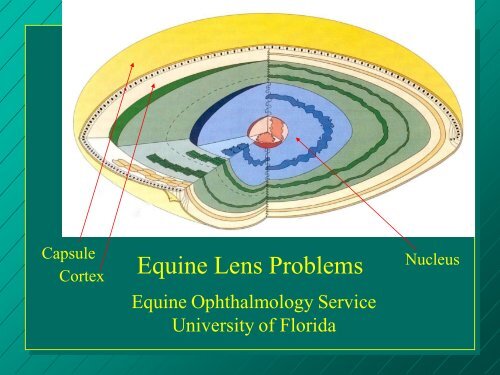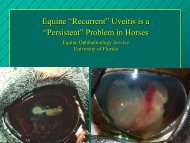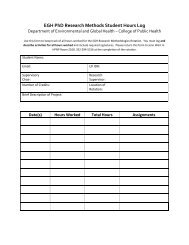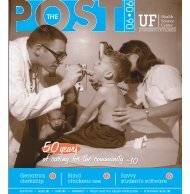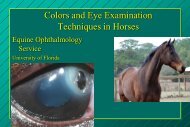Equine Lens Problems - University of Florida
Equine Lens Problems - University of Florida
Equine Lens Problems - University of Florida
- No tags were found...
Create successful ePaper yourself
Turn your PDF publications into a flip-book with our unique Google optimized e-Paper software.
•The lens sits in thepatellar fossa <strong>of</strong> thevitreous.•The horse has weak accommodation (< 2.0 D) to maintain afocussed retinal image.
21/4/2009Cigoto – Segmentación - Blastulación –Gástrulación – OrganogénesisImagen real de una blástula4
ERU cataract/synechia
Matt Stevens
• Multifocal lens with horizontal pupil• Zones <strong>of</strong> optical discontinuity
Nuclear cataract
Immature cataract
Morgan horse hereditary nuclear cataract
Whip injury
Therapy for Uveitic Cataracts• Medical: Oral aspirin might delay cataractformation in a few ERU horses• 10 mg/kg q24h• Surgery: Only chance for vision– Not easy– Client must be educated about the risks andbenefits, and must have realistic expectations!
• healthy foals(Rhodococcus free) andadult horses• no uveitis• visual impairment• the personality to toleratetopical therapy• Brisk PLRs and a dazzleindicate a functionalretina.• US (RDs)• ERG (esp Appaloosas)Cataract PatientCriteria
• ERG: Dark adapt 20minutes
ERG
Light Stimulus
US: mature cataract
US: posterior lens capsule rupture
RD: “seagull” sign
<strong>Lens</strong> fragments lying on retina.
“Phaco”
Phaco Surgical Procedure• Paralysis with atracurium• Scleral tunnel w/cautery• CCC• Standard SA needle; 15 mm• Horse needle is 23 mm• Machines• Hylartin-V viscoelastic• Mean phaco time: 10:05minutes (range 4:32 – 15:49)
Medications Postoperatively• Sulfas systemically for 5 days• Banamine (+/- omeprazole): several weeks• Topical Atropine: 2 weeks• Topical antibiotics: 2 weeks• Topical Prednisolone acetate: 1-3 months• Hospital stay: avg 8 days, range 3-15 days
Phacoemulsification.• Success rate ~ 83-98%initially in horses.– Declines rapidly with timedue to capsuler scarringand persistent uveitis– 49% at one month (OSU)– 44% at one year (TAMU)– 39% at 18 months (UF)• Surgery is easiest in foalsand yearlings.
• Complications: corneal ulcers, persistent corneal edemaand ulcers, glaucoma, hyphema, and infectiousendophthalmitis– Vision is functional but the aphakic horse should be hyperopic“far-sighted”• The aphakic equine globe is +9.9 D hyperopic (20/1200).– A 25 D IOL = +8.0 D
IOL
Intraocular <strong>Lens</strong>es (IOLs) in Horses
Knotty06
<strong>Lens</strong> Luxation in HorsesAnterior lens luxation
Aphakic crescentTrauma from cross ties
<strong>Lens</strong> subluxation4 wks later
<strong>Lens</strong> Cysts


